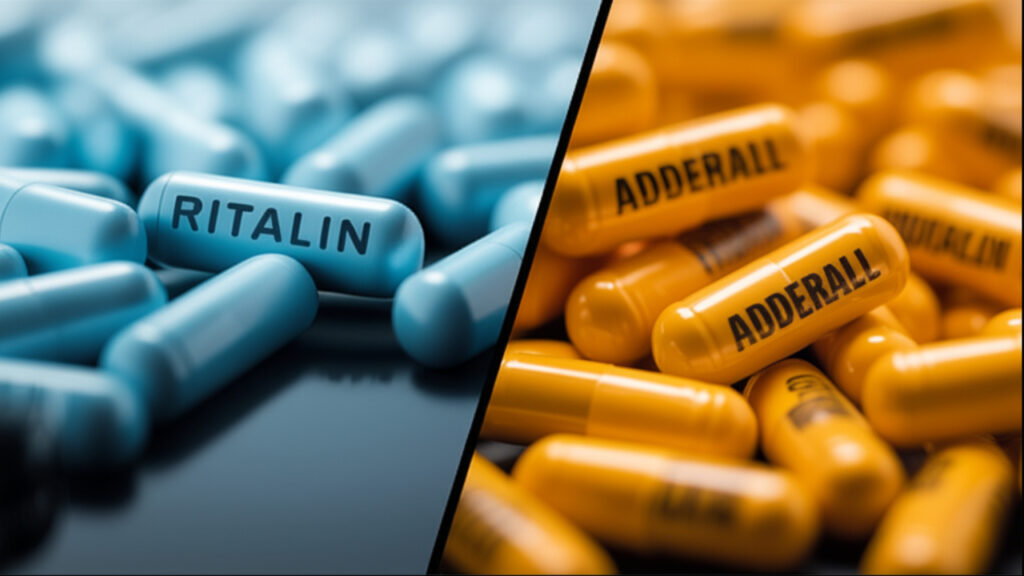What is the Difference Between Ritalin and Adderall?
Introduction
Ritalin and Adderall are two of the most widely prescribed stimulant medications for attention deficit hyperactivity disorder (ADHD). Both drugs target neurotransmitters in the central nervous system, but their active ingredients, effects, and risks differ. Patients, physicians, and families often compare their efficacy, side effects, and insurance coverage when deciding between them.
Understanding how methylphenidate (Ritalin) and amphetamine salts (Adderall) work in the brain is vital for patients managing ADHD, anxiety, or dual diagnosis conditions like major depressive disorder or bipolar disorder. This guide explains the similarities, differences, and important health factors to consider.
What is Ritalin?
Ritalin is the brand name for methylphenidate hydrochloride. It is a central nervous system stimulant that blocks the reuptake of dopamine and norepinephrine in the brain. This enables more neurotransmitter activity in the reward system, improving concentration, attention, and behavior in patients with ADHD.

Ritalin is available as both a tablet and a capsule. It is considered a controlled substance by the Drug Enforcement Administration (DEA) due to its risk for abuse and prescription drug addiction. Physicians may prescribe Ritalin for adults and children, though the American Academy of Pediatrics has strict guidelines for use in learning disorders.
Ritalin Side Effects
Common side effects include insomnia, headache, irritability, and nausea. Other adverse effects may involve weight loss, appetite suppression, fatigue, aggression, or stomach pain. Rarely, patients may experience hypertension, tachycardia, seizure, palpitations, migraine, or erection difficulties.
What is Adderall?
Adderall is a prescription drug made from a combination of amphetamine and dextroamphetamine. These stimulants act directly on the nervous system to increase dopamine and norepinephrine release. Adderall improves wakefulness, focus, and learning by stimulating the brain’s reward system.
Adderall comes in both capsule and tablet form and is also classified as a controlled substance by the Drug Enforcement Administration. It is widely prescribed for ADHD and sometimes used off-label for conditions like multiple sclerosis fatigue or resistant major depressive disorder under physician care.
Adderall Side Effects
Adderall shares many side effects with Ritalin, including insomnia, nausea, headache, irritability, and loss of appetite. Other risks include hypertension, tachycardia, anxiety, aggression, euphoria, paranoia, and adverse cardiovascular effects such as high blood pressure or heart rate changes. Patients with cardiovascular disease face added risk.

Key Differences Between Ritalin and Adderall
Active Ingredients
- Ritalin: methylphenidate hydrochloride
- Adderall: mixed amphetamine salts (amphetamine + dextroamphetamine)
Mechanism of Action
Ritalin primarily blocks dopamine and norepinephrine reuptake. Adderall releases dopamine and norepinephrine into the blood and brain while also blocking reuptake.
Onset and Duration
Ritalin acts quickly but may wear off sooner, requiring multiple doses per day. Adderall has a longer half-life and maintains efficacy with fewer doses.
Potency and Efficacy
Adderall is often considered to have greater potency compared to Ritalin. However, efficacy depends on individual response, comorbidities like anxiety or bipolar disorder, and the presence of dual diagnosis conditions such as substance abuse or major depressive disorder.
Risk of Abuse and Addiction
Both medications carry risk of prescription drug addiction and stimulant use disorder. Adderall is more frequently associated with euphoria and abuse. Ritalin, while also addictive, is sometimes considered to have slightly lower abuse potential.
Insurance and Access
Health insurance, including Medicare, often covers both drugs but may require prior authorization. Patients should verify coverage before starting treatment. Insurance plans sometimes favor generic drugs such as dexmethylphenidate or lisdexamfetamine (Vyvanse) over brand-name Ritalin or Adderall.
Ritalin vs Adderall: Health Considerations
Mental Health Conditions
Patients with ADHD often also face anxiety, depression, or bipolar disorder. A dual diagnosis requires careful psychiatry oversight to avoid worsening impulsivity, aggression, or irritability. Stimulants may interact with antidepressants like fluoxetine, paroxetine, or bupropion. For effective care, consider bipolar disorder treatment.
Physical Health Risks
Both drugs may increase blood pressure and heart rate, posing risks for patients with hypertension or cardiovascular disease. The Food and Drug Administration and the Centers for Disease Control and Prevention recommend screening for cardiac history before prescribing.
Drug Interactions
Ritalin and Adderall can dangerously interact with a monoamine oxidase inhibitor (MAOI) or monoamine oxidase antidepressant. Other drug interactions include atomoxetine, modafinil, and risperidone. Combining stimulants with methamphetamine or excessive caffeine raises risk for seizure, paranoia, or tachycardia.
Pregnancy and Safety
Neither drug is considered safe during pregnancy. Studies suggest possible effects on fetal brain development, blood pressure, and growth. Physicians advise avoiding stimulant use unless benefits outweigh risks.
Avoiding Misdiagnosis
ADHD symptoms can overlap with other mental health conditions, including anxiety, bipolar disorder, and major depressive disorder. Misdiagnosis may lead to unnecessary stimulant use, worsening side effects like insomnia, impulsivity, or irritability. Careful psychiatric evaluation reduces the risk of prescribing the wrong medication.
Patients should undergo a full assessment that includes medical history, family history of substance abuse, and screening for mood disorders. A physician must also rule out factors like sleep problems, nutrition deficiencies, or learning challenges before recommending a stimulant. Accurate diagnosis enables patients to receive the right treatment and avoid long-term risks.
Alternatives to Ritalin and Adderall
Patients who experience severe adverse effects or lack of efficacy may benefit from alternatives. These include non-stimulants like atomoxetine, antidepressants such as fluoxetine or bupropion, or stimulants like lisdexamfetamine and modafinil.
Therapy and lifestyle changes, including nutrition, sleep hygiene, and exercise, also improve ADHD symptoms. Some patients benefit from dialectical behavior therapy for impulsivity and aggression, while others explore cognitive behavioral therapy for concentration and anxiety.
How Revival Mental Health Can Help
At Revival Mental Health, we provide individualized treatment for ADHD and related conditions. Our psychiatry team carefully evaluates each patient’s symptoms, medical history, and risk factors before prescribing medication. We help patients weigh the risks and benefits of Ritalin versus Adderall while monitoring for side effects like blood pressure changes, headache, or fatigue.
Our treatment center also offers therapy options that address anxiety, impulsivity, and dual diagnosis conditions such as substance abuse or major depressive disorder. By combining medication management with evidence-based therapy, we help patients improve concentration, reduce risk, and strengthen long-term mental health.
Choosing Between Ritalin and Adderall
Selecting between Ritalin and Adderall depends on patient history, insurance coverage, and treatment goals. A physician evaluates dose requirements, risk of abuse, and possible adverse effect profiles. Health care providers also consider family history of substance abuse, cardiovascular disease, or mood disorder.
Patients should communicate openly about side effects like headache, stomach issues, irritability, fatigue, or appetite suppression. Monitoring blood pressure, heart rate, and sleep patterns ensures safety.

Conclusion
Ritalin and Adderall share many similarities as stimulant medications for ADHD but differ in chemical structure, potency, and side effect profiles. Ritalin uses methylphenidate, while Adderall combines amphetamine and dextroamphetamine. Each impacts dopamine, norepinephrine, and serotonin differently, altering efficacy, risk, and patient outcomes.
Ultimately, the best medication depends on the patient’s health, psychiatric history, insurance coverage, and physician guidance. Understanding these differences enables safer treatment decisions and better mental health care.
FAQs
1. Can Ritalin or Adderall cause long-term brain changes? Both drugs affect dopamine and norepinephrine activity in the brain. Long-term use may alter the nervous system’s reward system, but supervised treatment lowers risks.
2. Are generic drugs like dexmethylphenidate as effective as brand names? Yes, generic drugs meet FDA standards for efficacy and safety. Physicians may recommend them for patients with insurance restrictions or cost concerns.
3. How do Ritalin and Adderall affect appetite and nutrition? Both medications suppress appetite, which can lead to weight loss. Patients should focus on balanced nutrition to avoid fatigue or health problems.
4. Can patients with migraine or seizure disorders take these stimulants? Physicians exercise caution with patients who have migraines or seizure risk. Monitoring for adverse effects such as headache, stomach upset, or seizure activity is essential.





